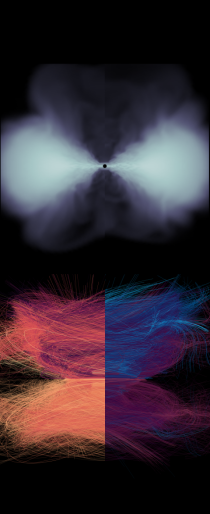Nucleosynthesis for Actinide Signatures in Metal-poor Stars
Student:Molly Kaufold Mentors:Sanjay Reddy (INSPIRE-HEP, email: sareddy@uw.edu) Kelsey Lund (INSPIRE-HEP, email: klund6@uw.edu) Prerequisites:None! What Students Will Learn:If the student is not familiar with Python, they will learn Python for the purposes of data analysis and visualization. The project will focus on the inter-play between nuclear physics and astrophysics. The student will learn how to identify and interpret nuclear abundances in stellar data from the literature, and become familiar with nucleosynthesis calculations for r-process. Depending on the interest of the student, there is also the opportunity to learn about large-scale supercomputer simulations or nuclear models (in the context of nucleosynthesis). Expected Project Length:At least 2 terms |
Image Credit: Snapshots from one of the post-merger disk simulations in [3]. |
Project Description:The rapid neutron capture process (r-process) is the nucleosyn-thetic process responsible for the creation of roughly half the material in the universe heavier than iron. In particular, the r-process is the only mechanism via which actinides, such as thorium, plutonium, and uranium, can be produced in nature. One of the most promising sites for heavy element, includ-ing actinide, production is the inspiral and merger of two neu-tron stars. Actinides produced and ejected from these catas-trophic events can then enrich material that later forms stars, leading to actinide signatures in these stars. A particularly intriguing observation is a range of actinide “richness” in metal-poor stars with r-process signatures [1, 2]. The extent to which r-process material is produced in neutron star merger environments is still very much an open question, which is subject to numerous sources of uncertainty, including both unmeasured properties of nuclei as well as incomplete information about the merger and post-merger systems. Recent work [3] has hinted at the possibility that variety in the magnetic field strength in the post-merger system could produce a variety of actinide richness. Testing this idea will require a more detailed survey of stellar measurements to bet-ter quantify the range of actinide enhancements observed in nature. These observations can then be compared to theoreti-cal predictions of yields from post-merger systems, such as the remnant black hole-accretion disk system (see figure). References:[1] E. M. Holmbeck, A. Frebel, G. C. McLaughlin, M. R. Mumpower, T. M. Sprouse, and R. Surman. Actinide-rich and actinide-poor r-process-enhanced metal-poor stars do not require separate r-process progenitors. The Astrophysical Journal, 881(1):5, Aug 2019.
|

